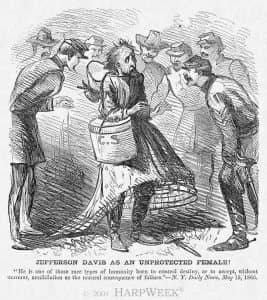by Cecil Brown
Even though many whites thought of him as the father of the “lost cause,” Jefferson Davis was for most African-Americans what racism symbolizes. From the end of slavery, recently freed ex-slaves felt the same way about him.
Ex-slave Dilly Yellandy remembers, “Old Jeff Davis said he wus goin’ to fight de Yankees till hell wus so full of em dat their legs us hangin’ over de sides.”
Slaves like Mr. Yellandy had heard about Jeff Davis, all right. They had heard about how he tried to run away and hide in a hole, like a fox, and how he tried to escape by wearing his wife’s dress.
Professor Jeff Greenburg has written brilliantly about how the rumor circulated that Jeff Davis had put on his wife’s dress and what this meant for Southern male status. There was a cartoon of him in his wife’s dress in the New York Daily News.
But slaves didn’t need a newspaper – which they couldn’t read anyway – to tell them about Jeff Davis.
As Mr. Yellandy tells it, “When they got ‘im [Jefferson Davis] in a close place, he dress in woman’s clothes an tried to git away from ‘em but dey seed his boots when he started to git in dat thing they rode in den, a carriage. Yes dats what it wus, a carriage. Dey seed his boots an knowed who it wus. Dey just laughed an pointed at ‘im an said you hold on dare. We got you, we knows who you is – an den dey took ‘im. He was mighty brave till dey got im in a close place; den he quit barking so loud.”
George Moses Horton, another ex-slave, observed the same action and heard the same stories about Jefferson Davis. Right away, he wrote the poem, “Jefferson in a Tight Spot.”
Feeding from the popular rumors about Jefferson as a sly fox, Horton begins with a subtitle of “The Fox Is Caught.” Using the metaphor of fox, Horton drills deeply into the White American racist hatred for Black people.
Alas! he speeds from place to place,
Such is the fox upon the chase;
But who can pity such a fox
Though buried among the rocks;
He’s a nuisance among the flocks,
And sucks the blood of geese.
He takes advantage of the step,
His nature is at night to keep,
And rob the flocks while the herdsmen sleep
When dogs can have no peace.
In the next stanza, Mr. Davis is trying to escape in women’s clothes, as Mr. Yellandy suggested, on his final capture.
But he is now brought to a bay,
However fast he run away,
He knows he has not gone to stay,
And assumes a raccoon’s dress,
Found in a hole, he veils his face,
And fain would take a lady’s place,
But fails for he has run his race,
And falls into distress.

George Moses Horton, the slave poet, and millions of others, knew what Jefferson Davis was. They took the Germans’ meaning of the word monument. “Denkmaler,” if my German is correct, means monument. But “Denk” is thought, and “maler” is a painting or a sculpture.
Black people knew then, as well as now, that the Confederate monuments meant an idea expressed in an artistic mode. White nationalists know this meaning, too – which is why they fight so hard for it.
The idea of white supremacy is the thought cast in cast-iron. It is a traditional way of expressing white Southern racism and slavery.
Trump, like Jefferson, is in a “tight place.”
Novelist and educator Cecil Brown, professor in the UC Berkeley History Department, is best known as the close friend, screenwriter and biographer of Richard Pryor and as the author of “The Life and Loves of Mr. Jiveass Nigger,” “Stagolee Shot Billy” and most recently “Pryor Lives: How Richard Pryor Became Richard Pryor: Kiss My Rich Happy Black Ass.” In an interview upon the release of the Pryor biography, JR Valrey wrote in the Bay View, “Cecil, although a UC Berkeley professor, is not writing about somebody he took up as an academic project; he is talking about somebody he knew personally, hung out with and loved as “potna.” Brown can be reached at browncecil8@me.com.






